Top 10 Best Fish for Planted Aquariums (Part III – Beauty & Noteworthy)
Posted by Artur Wlazlo on 29 Dec 2022
This is the third segment about the best aquarium fish for planted aquariums. In the previous two segments, we talked about the best algae-eating fish and scavenging fish for planted aquariums. This segment will focus on the fish that we believe look best and thrive in planted aquariums. However, there are quite literally hundreds of fish that fall into this category. So, necessarily this selection of fish for planted aquariums is highly personal and limited. Still, our picks are made based on our decades of plant and fishkeeping experience and we hope you find these recommendations helpful.
BEAUTIFUL AND NOTEWORTHY FISH FOR PLANTED AQUARIUM
Most fish we will list here - with one or two exceptions - are not particularly great at algae eating. They were chosen for their beauty and interesting behavior that truly flourish when kept in a planted aquarium. Many fish recommended here are small or nano fish with friendly dispositions that can be housed with a variety of other aquarium fish. However, in rounding up our selection, we decided to include a couple of larger fish to demonstrate that keeping them in planted aquariums is also possible and even desirable. Without further ado, below is our list of the best midwater and surface swimming fish for a planted aquarium:
6. Fancy Guppies & Platy
We noted above, that most fish listed here were not chosen for their algae-eating prowess. However, the Guppy is one fish on the list here that is both beautiful and quite good at algae-eating. Fancy Guppies are constantly grazing fish and will pick off small bits and pieces of food or algae from all objects and plants in the aquarium. By doing so, they keep both aquarium decorations and aquarium plants clean of debris and algae. They are also very beautiful fish with hundreds – perhaps thousands – of different color variants available in the hobby.
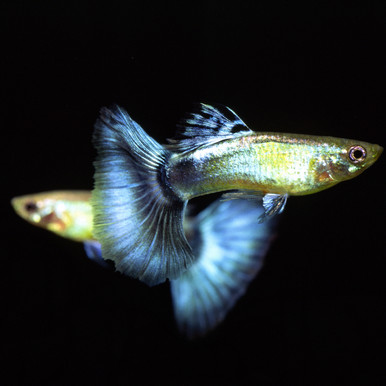
In the wild, guppies are widely distributed north of the Amazon, in the Caribbean, and extensively introduced into tropical and subtropical regions outside of their original home range. In the hobby since the early 1900s, the Guppy is one of the most popular and best-known fish in the hobby. It was named after Thomas Guppy who was the first one to identify it. There are hundreds of different color and pattern variations available in the hobby. They are adaptable, hardy fish and breed easily. Guppies can be kept in a wide range of aquarium conditions and are ideal for mixed community aquariums because of their small size and friendly disposition.
The female guppy gives birth to live offspring. Large females can produce over 150 fully-formed and free-swimming fry every 4-6 weeks. Unfortunately, they are likely to be cannibalized soon after birth unless they are separated from their parents (e.g. breeder chamber) or provided with lots of hiding places (e.g. floating plants). It is recommended to house these fish in well-planted aquariums with good lighting and some open swimming space. The fish will accept a wide range of foods, including flakes and small pellets.
Guppies can be kept with many other peaceful fishes, including tetras, plecos, cories, rasboras, and many other community fish.
Platies also deserve to be on this list. Platy is widely distributed in Central America, occurring in Veracruz state in Mexico, Belize, and Guatemala. There are different strains and color forms available. The platy fish is suitable for both a community aquarium and a single-species setup.
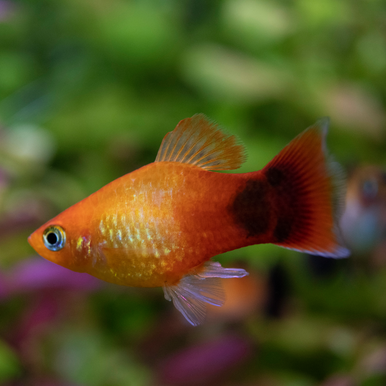
An ideal tank for these fish should include some open swimming areas with plants growing around the sides and the back of the aquarium. They are adaptable, hardy fish and breed easily. Platies can be kept in a wide range of aquarium conditions and are ideal for mixed community aquariums because of their small size and friendly disposition.
Platies are livebearers and will give birth to fully grown baby fish. Female platies can produce broods of up to eighty young every couple of months. However, they do not have any parental instincts and, if given the opportunity, will eat their own offspring. The fish will accept a wide range of foods, including flakes and small pellets. Like their cousin Guppy, they can be kept with many other peaceful fishes and many other community fish.
7. Tetras
Cardinal Tetra, Paracheirrodon axelrodi, is one of the most famous and popular species in the hobby. It is a truly beautiful fish and should be on everybody's must-have list. The cardinal tetra has a striking iridescent blue line that runs across its upper body and a vivid red line running below it. A large group of cardinal tetras, and the combination of the iridescent blue and vivid red they display, produce a stunning glittering effect in an aquarium and it is a sight to behold. The cardinal and neon tetra look similar but the neon tetra's red coloration extends only about half its body length.
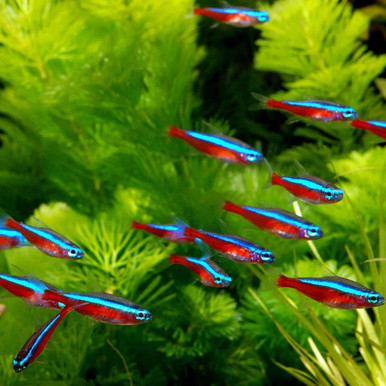
The small size of this nano fish means that it also has a very small bio-load. It can be kept in small aquariums and will not “pollute” aquarium water like other large fish. This makes the task of keeping them in planted aquariums easy.
Cardinal Tetras are small characins and belong to the Characidae family. It is native to the Orinoco River in Venezuela and the northern tributaries of the Rio Negro in Brazil and western Colombia. In nature, these fish are often found in tannin-stained and slow-moving waters, seeking shelter among aquatic plants, tree roots, and branches. They will tolerate a wide range of aquarium conditions and are particularly suited for community tanks because of their small size and peaceful temperament. They must be kept in groups of at least 6 individuals and preferably more.
In aquariums, cardinal tetras will appreciate well-planted tanks with open spaces. The placement of additional aquarium decorations such as driftwood and rocks is recommended. These aquascape features will provide shelter and make the fish feel safe. Cardinal tetras are shoaling fish and the larger the number of individuals the more striking their visual impact will be in the aquarium.
Cardinal tetras can be kept with many other peaceful fishes, including discus, dwarf cichlids, corydoras catfish, plecos, and many other community fish. They will readily accept a variety of foods, including flakes and small pellets.
Another member of the Tetra family, Silver-tipped tetra or Copper Tetra, Hasemania Nana, is worthy of inclusion on this list. Silver-tipped Tetra is a nano fish that lives up to its common name. Its body is warm yellow/golden with striking and contrasting silvery tips on its fins. Silver-tipped tetra is a fish perfectly suited for nano or community aquarium setups.
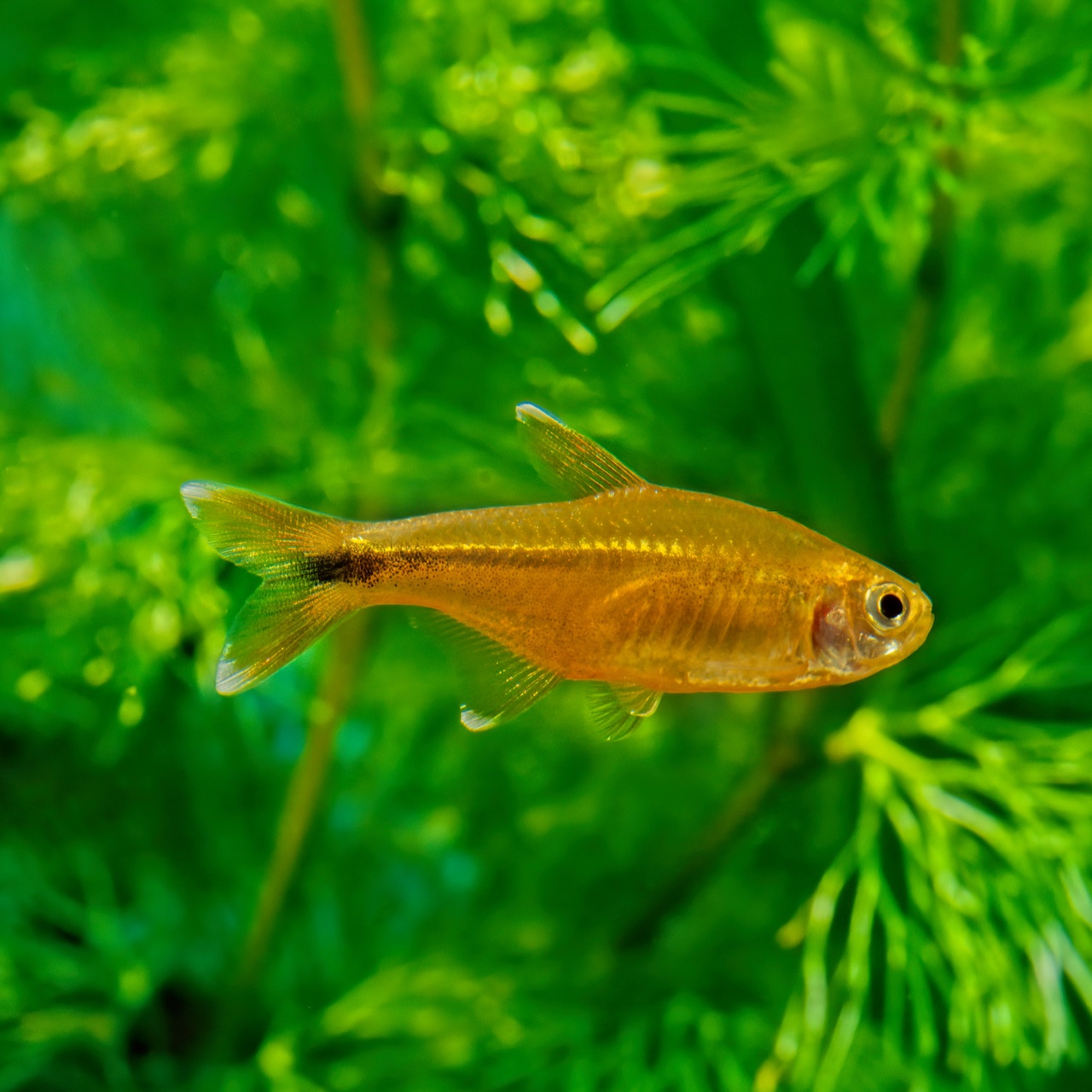
Silver-tipped Tetras are small characins and belong to the Characidae family. They are found in Eastern Brazil, the Sao Francisco Basin, and Western Brazil, the Purus River tributaries. In nature, these fish swim in large groups among plants and tree roots in slow-moving waters. Silver-tipped tetras will tolerate a wide range of aquarium conditions and should be kept in as large groups as possible. They look truly spectacular in large shoals.
In aquariums, they will appreciate plant thickets, driftwood, other aquarium decorations, and open swimming spaces.
Silver-tipped tetras can be kept with many other peaceful fishes, including discus, dwarf cichlids, corydoras catfish, plecos, and many other community fish. They will readily accept a variety of foods, including flakes and small pellets.
8. Dwarf Cichlids
German Ram, Mikrogeophagus ramirezi, is a spectacular dwarf cichlid and has been popular in the hobby for over 50 years. Indeed, German Ram is considered one of the "jewels" of the aquarium hobby. The fish sports very attractive colors from bright yellow and red to white and iridescent blue. Male specimens usually have the first few rays of the dorsal fin spectacularly extended. During spawning, their colors become even more vivid and the female's belly becomes pink/magenta. Males are a bit bigger than females.
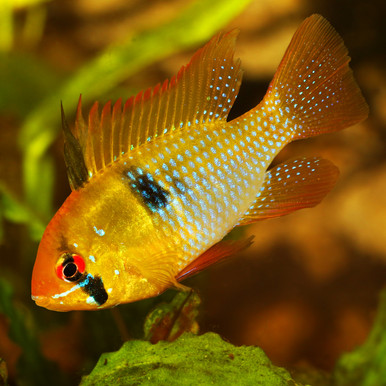
German Rams are dwarf cichlids and belong to the genius Mikrogeophagus in the family of Cichlidae. They are found in the Orinoco River basin in Venezuela as well as in Colombia. In nature, these fish generally inhabit slow-moving waters and areas where they can find cover from predators among plants, tree roots, and branches. They can be kept in a wide range of aquarium conditions and are particularly suited for planted and community tanks because of their small size and peaceful temperament.
In aquariums, German Rams will appreciate aquascape that includes live aquarium plants, decorations, driftwood, and rocks. These aquascape features will provide shelter and make the fish feel safe. Once they feel happy, German Rams will readily spawn. They will lay eggs on a precleaned site (e.g. stone) or in a depression in the substrate. German Rams are good parents and will take care of their fry, shooing away any potential intruders from the immediate area where the fry is.
German Rams can be kept with many other peaceful fishes, including discus, tetras, other dwarf cichlids, corydoras catfish, plecos, and many other community fish. They will readily accept a variety of foods, including flakes, pellets, freeze-dried and frozen foods.
Another member of the Dwarf Cichlid family that deserves our pick for fish in a planted aquarium is Kribensis Cichlid. It is also known as Pelvicachromis pulcher or simply Krib, and is perhaps the most popular African cichlid in the hobby. It is a colorful fish with yellowish, reddish to pinkish accents on a light-colored body with a horizontal black stripe running the length of its body. The female, especially when breeding, will develop a rounded belly and exhibit a particularly striking reddish/pinkish belly patch.
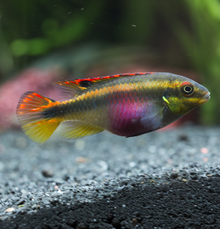
Kribensis Cichlid occurs in forested small streams and rivers in Nigeria. They are peaceful toward other species but can be somewhat territorial - or protective - during breeding time. They are easy and good beginner cichlids. Their small size makes them ideal cichlids for small aquariums, housing other small and peaceful fish such as tetras, rasboras, barbs, or even guppies.
Kribensis Cichlid would do well in well-planted aquariums with lots of hiding places provided by rocks, caves, and driftwood. Good filtration and good water quality are recommended. The fish will lay eggs on the roof of a cave. Both parents guard the eggs and newly hatched fry.
The fish will accept a variety of foods, including flakes and pellets.
9. Angel Fish
Angelfish are graceful cichlids and one of the most popular aquarium fish in the hobby. They belong to the genius Pterophylum and the family Cichlidae which is comprised of many fish species. There are many different color variants available in the hobby, including Koi Angelfish, Black Angelfish, Blue Angelfish, and many more.
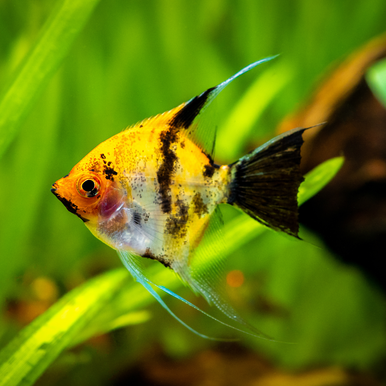
In the wild, they are widely distributed in the Amazon basin, from Peru to the mouth of the Amazon River at Belem. They are great beginner fish and do well in planted and community aquariums. They are undemanding but, like most cichlids, they are social fish and should be kept in groups.
They should be housed in medium (20 gal+) to large size aquariums. Aquariums with live aquarium plants and driftwood will mimic the Angelfish's natural habitat and make them feel at home. Angelfish will readily accept all kinds of foods and should be fed a variety of them, including flakes, pellets, and granules.
If provided with good conditions, Angelfish will breed easily, laying their eggs on a vertical surface such as glass, leaves of a sword plant, driftwood, or even aquarium heaters. Their breeding behavior is truly captivating. The females can lay up to 1,000 eggs. The pair are good parents and will guard the eggs as well as the fry.
10. Discus Fish
A discus fish is a cichlid and belongs to a large family, Cichlidae, of many different fishes such as angelfish or dwarf cichlids. They are found on only one continent, South America. Specifically, they inhabit the blackwater rainforest tributaries of the Amazon River. There, they swim near the shorelines where the water is slow-moving and hide among tangled roots and branches for safety from predators.
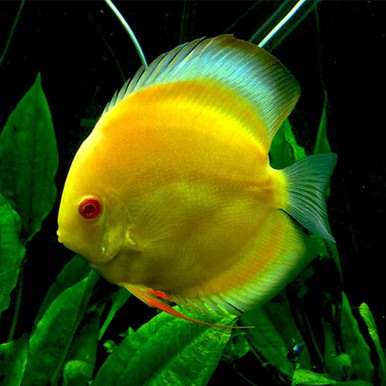
They are social fish and should be kept in groups of at least six individuals and once their pecking order is established, they will live in harmony and coexist peacefully with other fish. They can be kept in a wide range of aquarium conditions as long as they are provided with clean water, stable conditions, and a proper diet.
Discus fish are widely admired in the aquarium hobby for their beauty and intelligence. Their colors and patterns make them one of the most beautiful species available in the bobby. They are the "personality" fish and will often interact with their keepers. Their spawning behavior and the care they show for their young are equally fascinating.
Discus fish can be kept with many other peaceful fish, including tetras, dwarf cichlids, corydoras catfish, plecos, and many others.
These are our picks for the most beautiful and interesting fish for a planted aquarium. Many other fish can – and should be – kept in planted aquariums. Fish look their best and feel safe swimming among aquatic plants. They both are the perfect complement to each other.

